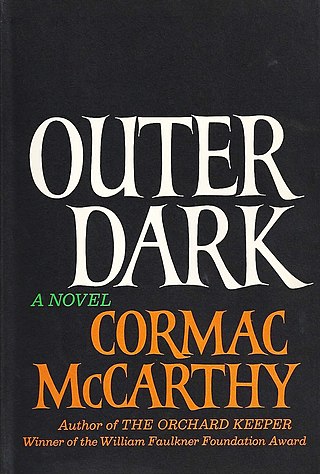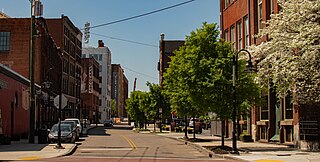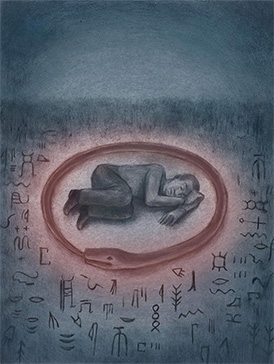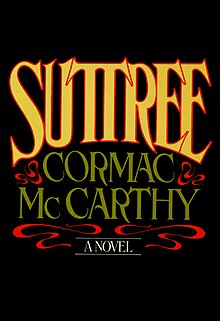
Cormac McCarthy was an American writer who authored twelve novels, two plays, five screenplays, and three short stories, spanning the Western and postapocalyptic genres. His works often included graphic depictions of violence, and his writing style was characterised by a sparse use of punctuation and attribution. He is widely regarded as one of the greatest American novelists.

Blood Meridian; or, The Evening Redness in the West is a 1985 epic historical novel by American author Cormac McCarthy, classified under the Western, or sometimes the anti-Western, genre. McCarthy's fifth book, it was published by Random House.

The Orchard Keeper is the first novel by the American novelist Cormac McCarthy. It won the 1966 William Faulkner Foundation Award for notable first novel.

Outer Dark is the second novel by American writer Cormac McCarthy, published in 1968. The time and setting are nebulous, but can be assumed to be somewhere in Appalachia, sometime around the turn of the twentieth century. The novel tells of a woman named Rinthy who bears her brother's baby. The brother, Culla, leaves the nameless infant in the woods to die, but tells his sister that the newborn died of natural causes and had to be buried. Rinthy discovers this lie and sets out to find the baby for herself.

Child of God (1973) is the third novel by American author Cormac McCarthy. It depicts the life of a violent outcast and serial killer in 1960s Appalachian Tennessee.

The Crossing is a novel by American author Cormac McCarthy, published in 1994 by Alfred A. Knopf. The book is the second installment of McCarthy's "Border Trilogy," following the award-winning All the Pretty Horses (1992), to which The Crossing has been both favorably and unfavorably compared.

Cities of the Plain is the final volume of American novelist Cormac McCarthy's "Border Trilogy", published in 1998. The title is a reference to Sodom and Gomorrah.
Miller's Department Store was a chain of department stores based in East Tennessee.

Jerome Charyn is an American writer. With nearly 50 published works over a 50-year span, Charyn has a long-standing reputation as an inventive and prolific chronicler of real and imagined American life, writing in multiple genres.

The Road is a 2006 post-apocalyptic novel by American writer Cormac McCarthy. The book details the grueling journey of a father and his young son over a period of several months across a landscape blasted by an unspecified cataclysm that has destroyed industrial civilization and almost all life. The novel was awarded the 2007 Pulitzer Prize for Fiction and the James Tait Black Memorial Prize for Fiction in 2006. The book was adapted into a film of the same name in 2009, directed by John Hillcoat.

The Old City is a neighborhood in Knoxville, Tennessee, United States, located at the northeast corner of the city's downtown area. Originally part of a raucous and vice-ridden section of town known as "The Bowery," the Old City has since been revitalized through extensive redevelopment efforts carried out during the 1980s through the present. Currently, the Old City is an offbeat urban neighborhood, home to several unique restaurants, bars, clubs, and shops.

The Knox County Courthouse is a historic building located at 300 Main Street in Knoxville, Tennessee, United States. Built in 1886, it served as Knox County's courthouse until the completion of the City-County Building in 1980, and continues to house offices for several county departments. John Sevier, Tennessee's first governor, is buried on the courthouse lawn. The courthouse is listed on the National Register of Historic Places for its architecture and its role in the county's political history.

The Omni Grove Park is a historical resort hotel on the western-facing slope of Sunset Mountain within the Blue Ridge Mountains, in Asheville, North Carolina. This hotel was visited by various Presidents of the United States mentioned below.

Gay Street is a street in Knoxville, Tennessee, United States, that traverses the heart of the city's downtown area. Since its development in the 1790s, Gay Street has served as the city's principal financial and commercial thoroughfare, and has played a primary role in the city's historical and cultural development. The street contains Knoxville's largest office buildings and oldest commercial structures. Several buildings on Gay Street have been listed on the National Register of Historic Places.

Peter Josyph is a New York artist who works concurrently as an author, a painter, an actor-director, a filmmaker, and a photographer.

Child of God is a 2013 American crime drama film co-written and directed by James Franco, and starring Scott Haze, based on the novel of the same name by Cormac McCarthy. It was selected to be screened in the official competition at the 70th Venice International Film Festival and was an official selection of the 2013 Toronto International Film Festival. The film made its United States premiere at the 51st New York Film Festival and then was screened at the 2013 Austin Film Festival.

A list of works by or about Cormac McCarthy, the American novelist, playwright, and screenwriter. McCarthy published twelve novels, spanning the Southern Gothic, Western, and post-apocalyptic genres, as well as multiple short-stories, screenplays, plays, and an essay.

"The Kekulé Problem" is a 2017 essay written by the American author Cormac McCarthy for the Santa Fe Institute (SFI). It was McCarthy's first published work of non-fiction. The science magazine Nautilus first ran the article online on April 20, 2017, then printed it as the cover story for an issue on the subject of consciousness. David Krakauer, an American evolutionary biologist who had known McCarthy for two decades, wrote a brief introduction. Don Kilpatrick III provided illustrations.

The Passenger is a 2022 novel by the American writer Cormac McCarthy. It was released six weeks before its companion novel Stella Maris. The plot of both The Passenger and Stella Maris follows Bobby and Alicia Western, two siblings whose father helped develop the atomic bomb.

The Cormac McCarthy Journal is a biannual peer-reviewed academic journal of literary criticism dedicated to the study of the American author Cormac McCarthy (1933–2023). The journal launched in 2001 as an annual publication of the Cormac McCarthy Society. Since 2015, issues are published on a biannual basis by the Penn State University Press.


















